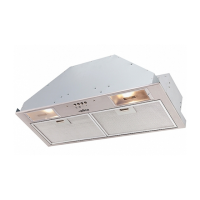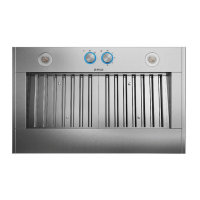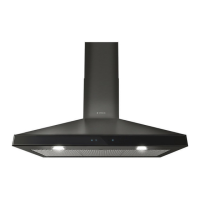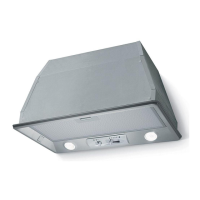5
LOCATION REQUIREMENTS
Product dimensions
I* - Metallic spacers
Spacers has to be
installed and used
when cabinet depth
is greater than 12”.
E
A
B
C
F
G
H
D
I*
I*
Model
EPR628S1
A 28
17
⁄64” (71.8 cm)
B 26” (66 cm)
C 1
9
⁄64” (2.9 cm)
D 10¾” (27.3 cm)
E 9
17
⁄32” (24.2 cm)
F 0
21
⁄64” (.85 cm)
G 14
9
⁄16” (37 cm)
H 6” (15.2 cm)
I* ½” (1.27 cm)
For gas range installation: Mount this hood so that the bottom
edge is at minimum 27”(68,5 cm) above the cooking surface.
For electric range installation: mount this hood so that the
bottom is not less than 24”(61 cm).
Installation clearances
E
A
B
C
F
D
A. 12” (30.5 cm) min. upper
cabinet height
B. 30” (76.2 cm) cabinet
opening width*
C. 24” (61 cm) min. 36” (91.4 cm)
suggested max. bottom of
cabinet to cooking surface
D. 12” (30.48 cm) cabinet opening
depth*
E. 15” (38.1 cm) min. clearance
upper cabinet to countertop
F. 36” (91.4 cm) base cabinet
height
*NOTE: This range hood is set to 30” (76.2 cm) cabinet width
x 12” (30.5 cm) deep cabinets.
Venting requirements
• Vent system must terminate to the outdoors, except for no
vented (recirculating) installations.
• Do not terminate the vent system in an attic or other
enclosed area.
• Do not use a 4” (10.2 cm) laundry-type wall cap.
• Rigid metal vent is recommended. Plastic or metal foil
vent is not recommended. The length of vent system and
number of elbows should be kept to a minimum to provide
ecient performance.
For the most ecient and quiet operation:
• Use no more than three 90° elbows.
• Make sure there is a minimum of 24” (61 cm) of straight
vent between the elbows if more than 1 elbow is used.
• Do not install 2 elbows together.
• Use clamps to seal all joints in the vent system.
• The vent system must have a damper.
• Use caulking to seal exterior wall or roof opening around
the cap.
• The size of the vent should be uniform.
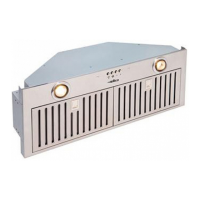
